Quick Home Hypothyroidism Self-Test – No Kit Needed

The First Signs of a Nutrient Deficiency
Learn how to recognize early symptoms related to specific nutrient deficiencies
Receive a downloadable list of early indicators your body is lacking key nutrients

The First Signs of a Nutrient Deficiency
Learn how to recognize early symptoms related to specific nutrient deficiencies
Receive a downloadable list of early indicators your body is lacking key nutrients

The First Signs of a Nutrient Deficiency
Learn how to recognize early symptoms related to specific nutrient deficiencies
Receive a downloadable list of early indicators your body is lacking key nutrients

The First Signs of a Nutrient Deficiency
Learn how to recognize early symptoms related to specific nutrient deficiencies
Receive a downloadable list of early indicators your body is lacking key nutrients

The First Signs of a Nutrient Deficiency
Learn how to recognize early symptoms related to specific nutrient deficiencies
Receive a downloadable list of early indicators your body is lacking key nutrients

The First Signs of a Nutrient Deficiency
Learn how to recognize early symptoms related to specific nutrient deficiencies
Receive a downloadable list of early indicators your body is lacking key nutrients

The First Signs of a Nutrient Deficiency
Learn how to recognize early symptoms related to specific nutrient deficiencies
Receive a downloadable list of early indicators your body is lacking key nutrients

The First Signs of a Nutrient Deficiency
Learn how to recognize early symptoms related to specific nutrient deficiencies
Receive a downloadable list of early indicators your body is lacking key nutrients

The First Signs of a Nutrient Deficiency
Learn how to recognize early symptoms related to specific nutrient deficiencies
Receive a downloadable list of early indicators your body is lacking key nutrients

The First Signs of a Nutrient Deficiency
Learn how to recognize early symptoms related to specific nutrient deficiencies
Receive a downloadable list of early indicators your body is lacking key nutrients

The First Signs of a Nutrient Deficiency
Learn how to recognize early symptoms related to specific nutrient deficiencies
Receive a downloadable list of early indicators your body is lacking key nutrients

The First Signs of a Nutrient Deficiency
Learn how to recognize early symptoms related to specific nutrient deficiencies
Receive a downloadable list of early indicators your body is lacking key nutrients
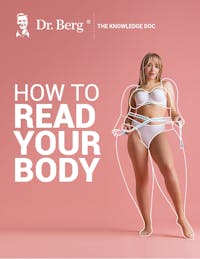
How to Read Your Body
Learn to recognize common symptoms and uncover their underlying health issues
Understand the signs of nutrient deficiencies to manage your health
Explore the four metabolic body types and the core factors that influence them
Interpret your body's signals from head to toe to identify potential health concerns

How to Read Your Body
Learn to recognize common symptoms and uncover their underlying health issues
Understand the signs of nutrient deficiencies to manage your health
Explore the four metabolic body types and the core factors that influence them
Interpret your body's signals from head to toe to identify potential health concerns

How to Read Your Body
Learn to recognize common symptoms and uncover their underlying health issues
Understand the signs of nutrient deficiencies to manage your health
Explore the four metabolic body types and the core factors that influence them
Interpret your body's signals from head to toe to identify potential health concerns

How to Read Your Body
Learn to recognize common symptoms and uncover their underlying health issues
Understand the signs of nutrient deficiencies to manage your health
Explore the four metabolic body types and the core factors that influence them
Interpret your body's signals from head to toe to identify potential health concerns

How to Read Your Body
Learn to recognize common symptoms and uncover their underlying health issues
Understand the signs of nutrient deficiencies to manage your health
Explore the four metabolic body types and the core factors that influence them
Interpret your body's signals from head to toe to identify potential health concerns

How to Read Your Body
Learn to recognize common symptoms and uncover their underlying health issues
Understand the signs of nutrient deficiencies to manage your health
Explore the four metabolic body types and the core factors that influence them
Interpret your body's signals from head to toe to identify potential health concerns

How to Read Your Body
Learn to recognize common symptoms and uncover their underlying health issues
Understand the signs of nutrient deficiencies to manage your health
Explore the four metabolic body types and the core factors that influence them
Interpret your body's signals from head to toe to identify potential health concerns

How to Read Your Body
Learn to recognize common symptoms and uncover their underlying health issues
Understand the signs of nutrient deficiencies to manage your health
Explore the four metabolic body types and the core factors that influence them
Interpret your body's signals from head to toe to identify potential health concerns

How to Read Your Body
Learn to recognize common symptoms and uncover their underlying health issues
Understand the signs of nutrient deficiencies to manage your health
Explore the four metabolic body types and the core factors that influence them
Interpret your body's signals from head to toe to identify potential health concerns

How to Read Your Body
Learn to recognize common symptoms and uncover their underlying health issues
Understand the signs of nutrient deficiencies to manage your health
Explore the four metabolic body types and the core factors that influence them
Interpret your body's signals from head to toe to identify potential health concerns

How to Read Your Body
Learn to recognize common symptoms and uncover their underlying health issues
Understand the signs of nutrient deficiencies to manage your health
Explore the four metabolic body types and the core factors that influence them
Interpret your body's signals from head to toe to identify potential health concerns

How to Read Your Body
Learn to recognize common symptoms and uncover their underlying health issues
Understand the signs of nutrient deficiencies to manage your health
Explore the four metabolic body types and the core factors that influence them
Interpret your body's signals from head to toe to identify potential health concerns
Hypothyroidism is a common thyroid disease that can significantly impact various aspects of health.
Primary hypothyroidism is characterized by elevated levels of thyroid-stimulating hormone, which can easily be determined with a blood test. However, secondary hyperthyroidism can have many underlying causes and often is more challenging to diagnose.
Learn how you can check your thyroid health using a quick and easy at-home thyroid test that doesn’t require a blood sample or test kit.
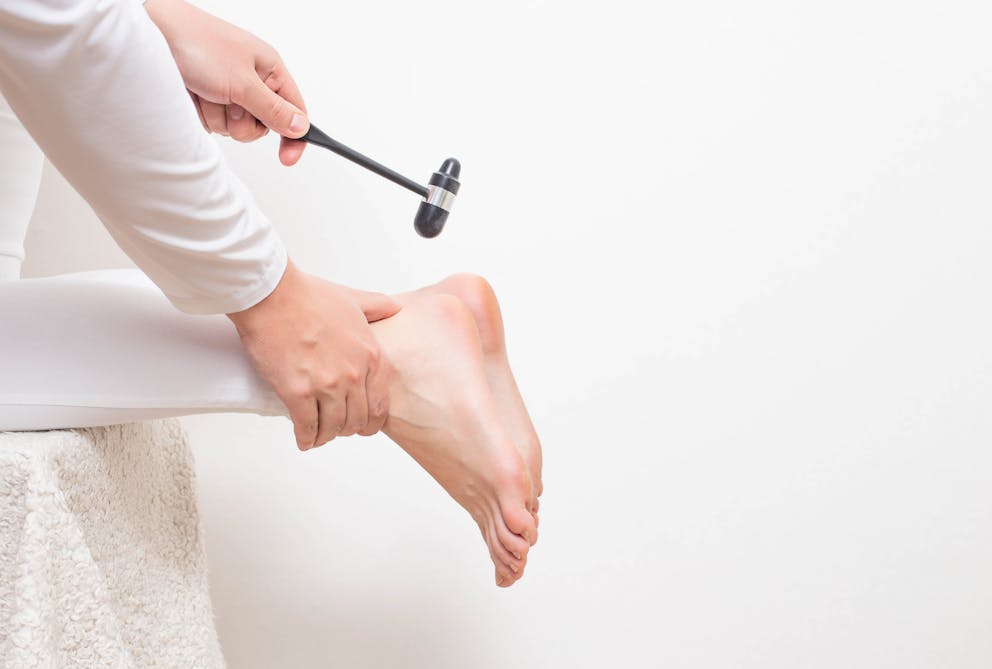
How to do a hypothyroidism self-test at home
Performing an at-home thyroid function test is easy and doesn’t require a blood sample. All you need is a chair and a reflex hammer. If you don’t have a reflex hammer, you can use the back of a screwdriver or the handle of a butter knife.
This test, also known as the Woltman reflex test, is a neurological diagnostic tool that assesses how quickly your muscles relax after a reflex is triggered. Slow muscle relaxation can be a clinical sign of thyroid dysfunction, especially hypothyroidism.
How to perform the hypothyroidism self-test:
Kneel on a chair and tap your Achilles tendon with a reflex hammer or any other suitable tool to trigger an involuntary reflex.
Watch how quickly your foot returns to a fully relaxed position.
Typically, the muscles in your leg relax immediately and entirely after the reflex has been triggered.
However, in individuals with hyperthyroidism, the leg muscles may continue to contract for a brief period before finally relaxing. This delayed relaxation is known as the Woltman reflex and is indicative of underactive thyroid function.
Watch the video below to learn how this at-home thyroid test can help determine if you have a thyroid problem.
How reliable is this thyroid test?
While the Woltman reflex isn’t a definitive diagnostic test, it’s a beneficial screening test that helps to support a diagnosis when used in conjunction with other signs and symptoms of hyperthyroidism.
A study published in the Canadian Medical Association Journal reported, "Delayed relaxation of deep tendon reflexes (Woltman sign) is seen in about 75% of patients with hypothyroidism and has a positive predictive value of 92% in overtly hypothyroid patients.”
More ways to test for hypothyroidism
Hypothyroidism is typically diagnosed with a thyroid blood test which measures thyroid-stimulating hormone (TSH), thyroid antibodies, and thyroid hormone levels.
TSH is produced by the pituitary gland in response to low levels of thyroid hormones in the blood. High levels of TSH indicate that the thyroid gland isn’t producing enough thyroid hormone, while low levels of TSH may indicate an overactive thyroid that’s making too much thyroid hormone.
Several convenient at-home thyroid test kits are available that test for TSH, thyroid hormones, and thyroid peroxidase antibodies.
A thyroid antibody test can help detect Hashimoto's thyroiditis, an autoimmune thyroid disorder responsible for almost 90 percent of hypothyroidism cases.
In addition, a physical examination or ultrasound scan of the neck area can be performed to check for thyroid nodules, and an iodine patch test can help assess levels of iodine, an essential mineral needed to produce thyroid hormones.
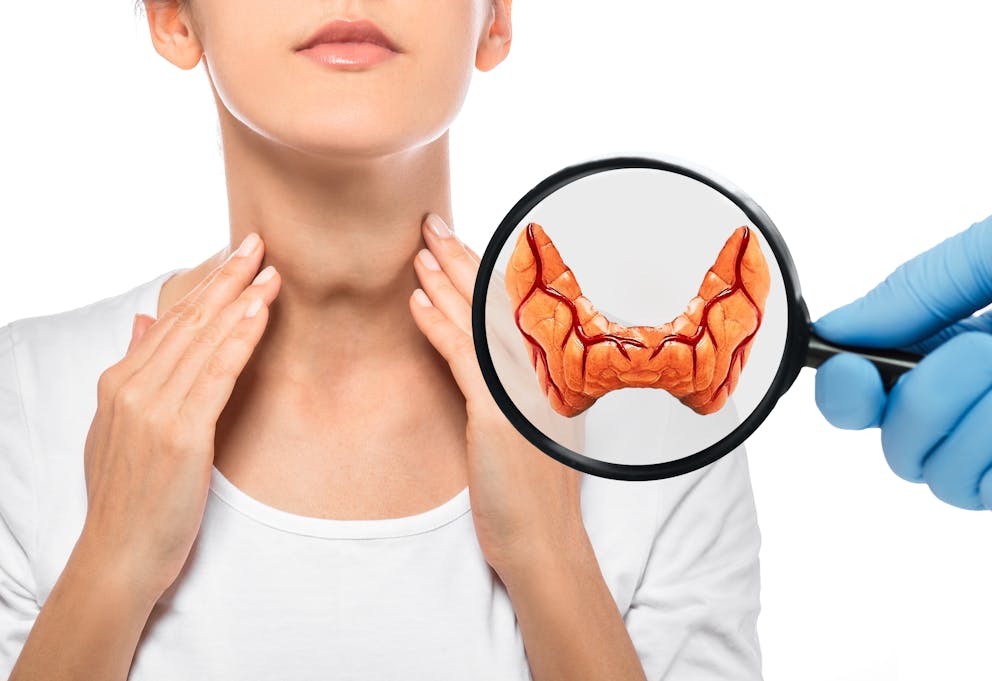
What is the thyroid?
The thyroid is an endocrine gland located below the Adam's apple in the neck. Its primary function is the production of thyroid hormones and calcitonin, an important calcium-regulating hormone.
The production of thyroid hormones is controlled by the hypothalamus and pituitary gland. The hypothalamus signals the pituitary gland to produce TSH, which stimulates the thyroid gland to produce and release the two main thyroid hormones, thyroxine (T4) and triiodothyronine (T3).
What does the thyroid do?
Thyroid hormones regulate almost all aspects of your metabolism and play a critical role in growth and development. They also help to control body temperature, heart rate, protein production, and gene expressions that influence cellular energy production.
T3, the active form of thyroid hormones, increases cellular oxygen and nutrient turnover, ramping up energy expenditure and heat production, also known as the basal metabolic rate.
Liver, muscle, and fat cells appear to have the most thyroid hormone receptors, and their cellular functioning is significantly governed by thyroid hormones.
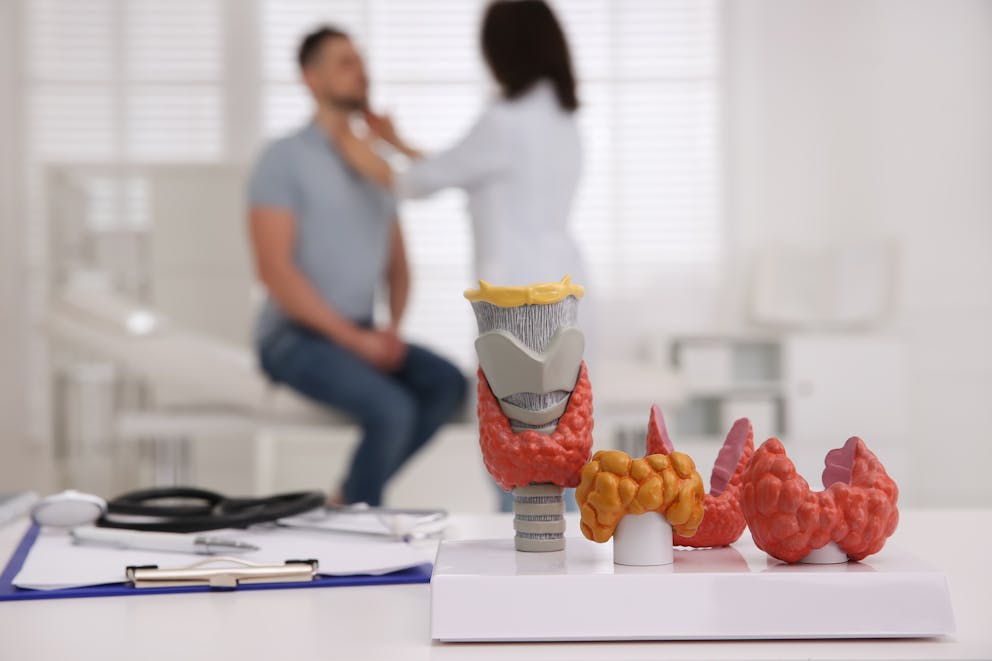
Signs of hypothyroidism
Hypothyroidism is characterized by low levels of circulating thyroid hormones which can manifest in a wide range of signs and symptoms.
It’s also important to note that not everyone with hypothyroidism has symptoms, especially in the early stages. However, symptoms will likely develop as hypothyroidism progresses or becomes more severe.
Here are common signs and symptoms of hypothyroidism:
Fatigue
Cholesterol
Depression
Weight gain
Constipation
Hair loss
Dry skin and brittle nails
Intolerance to cold

What causes an underactive thyroid?
90 percent of hypothyroidism is caused by Hashimoto’s thyroiditis, an autoimmune disorder that triggers immune cells to mistakenly attack the thyroid gland, causing inflammation and tissue damage.
Interestingly, research published in Experimental and Clinical Endocrinology & Diabetes suggests that gluten, a protein found in many cereal grains such as wheat and rye, may be a common trigger of Hashimoto’s thyroiditis. The authors suggest “That the gluten-free diet may bring clinical benefits to women with autoimmune thyroid disease.”
Hypothyroidism can sometimes develop due to a lack of dietary iodine, a crucial mineral needed to produce thyroid hormones.
An iodine deficiency can result in your thyroid having to work harder, which can cause thyroid nodules or enlarge the thyroid gland, a condition known as goiter.
Another mineral that’s essential for normal thyroid function is selenium. Without adequate selenium, inactive thyroid hormone (T4) can’t be converted into the active form (T3), which explains why selenium deficiency can result in hypothyroidism despite normal thyroid hormone production.
Thyroid hormone conversion occurs mainly in the liver and kidneys, and individuals with kidney or liver disease, diabetes, or sluggish gallbladder function may not be able to convert adequate amounts of T4 into T3.
“Women are more likely to develop hypothyroidism,” explains Dr. Berg. “There is a strong connection between hypothyroidism and estrogen dominance, and assessing estrogen levels is an important step in managing hypothyroidism in women.”

Natural ways to reduce the progression of hypothyroidism
Although there isn’t a cure for autoimmune hypothyroidism, there are plenty of steps that you can take to support thyroid function and promote thyroid hormone production and conversion.
Here are five natural ways to support your thyroid health:
1. Avoid gluten
In some individuals, gluten triggers the immune system to attack the thyroid gland, and a gluten-free diet can significantly improve hypothyroidism symptoms in individuals with Hashimoto’s thyroiditis.
2. Support liver health
More than 80 percent of thyroid hormone conversion occurs in the liver, and people with liver disease such as fatty liver or cirrhosis typically have lower circulating levels of T3.
Avoiding alcohol and limiting exposure to toxins by eating nutritious and organic foods can help regenerate liver cells and promote normal liver function.
3. Take bile salts
There is some evidence that bile salts may play a role in regulating thyroid hormone levels.
Bile salts appear to increase the absorption of thyroid hormones from the small intestine, which increases circulating levels and cellular availability of T3.
4. Consume a nutrient-rich diet
Thyroid health relies on many nutrients, and consuming a nutritious diet is crucial to slow the progression of hypothyroidism.
A nutrient-dense, low-carb diet like Healthy Keto® is an excellent choice to support your thyroid. Healthy Keto focuses on iodine-rich foods such as fish, seafood, and dairy products and limits gluten-containing foods.
In addition, the ketogenic diet improves insulin sensitivity, which can help to regulate thyroid hormone production and metabolism.
5. Increase selenium-rich foods
Regularly consuming selenium-rich foods supports thyroid hormone conversion.
Brazil nuts are incredibly rich sources of selenium. In fact, eating one Brazil nut per day is typically enough to obtain all the selenium your body needs to convert T4 into active T3.
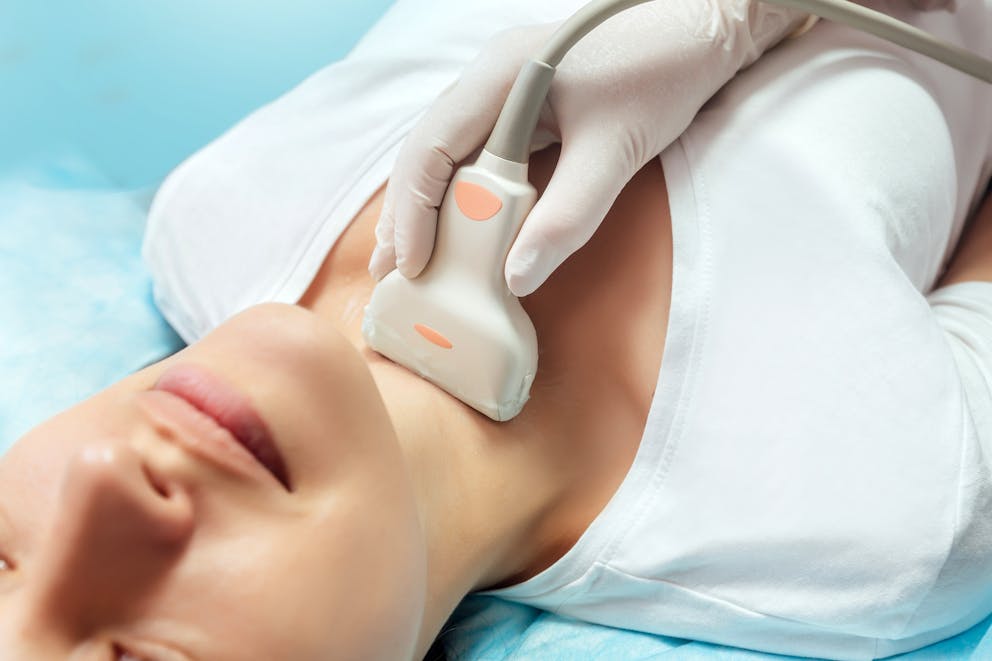
When to contact your doctor
Hypothyroidism and hyperthyroidism, also known as an overactive thyroid gland, are both thyroid disorders that can cause a wide range of symptoms and complications due to the disruption of thyroid hormone balance in the body.
If you suspect that you have thyroid issues, experience symptoms of hypothyroidism, or see negative results while doing at-home thyroid testing, it’s essential to consult with a healthcare provider.
A licensed physician can check thyroid levels and perform in-depth thyroid function tests to determine the health of your thyroid gland. Though at-home thyroid tests can be helpful, lab testing may be necessary to diagnose common thyroid disorders.
While most cases of thyroid disorders are easily managed with lifestyle modifications and prescription drugs, in some instances, hypothyroidism symptoms can be due to thyroid cancer.
Early detection significantly improves prognosis, and you shouldn't delay seeing a medical provider if you have a lump in your throat, suffer unexplained hoarseness, or have difficulty swallowing.

Key takeaways
Hypothyroidism is a common thyroid disorder that can cause weight gain, fatigue, dry skin, and brittle hair. However, not all individuals with hypothyroidism develop symptoms, making a diagnosis difficult.
Performing the Woltman reflex test is a simple diagnostic tool that can help you determine your thyroid health by checking how quickly your muscles relax after an involuntary reflex.
Avoiding gluten and following a nutrient-dense low-carb keto diet can promote thyroid health. In addition, increasing selenium-rich foods and taking bile salts can support liver function and stimulate the conversion of active T3.
FAQ
1. What is hypothyroidism?
Hypothyroidism is a common thyroid disorder characterized by low levels of thyroid hormones. While in most cases, the thyroid gland doesn’t produce enough thyroid hormones, hypothyroidism can also develop due to poor conversion of inactive thyroid hormone T4 into the active form T3.
2. Is it hard to detect hypothyroidism?
Hypothyroidism can be difficult to detect because symptoms can be vague and may overlap with symptoms of other health conditions. In addition, some people may not show any symptoms, especially during the early stages of hypothyroidism, making an early diagnosis challenging.
3. What is the first sign of hypothyroidism?
The first signs of hypothyroidism can vary from person to person. However, fatigue and unexplained weight gain are often among the first symptoms of underactive thyroid function.
4. How can I test my thyroid at home?
There is a range of convenient at-home thyroid tests available. In addition, you can perform the Woltman reflex test, a simple test that shows how quickly your leg muscles relax after an involuntary reflex has been triggered by tapping the Achilles tendon.
Slow muscle relaxation is indicative of hypothyroidism, especially if other symptoms of an underactive thyroid are present.
5. How can I do thyroid tests without going to the doctor?
At-home kits are readily available online and in drugstores and often are cheaper than visiting a doctor. Choose a test that assesses a comprehensive thyroid panel, including thyroid antibodies, thyroid stimulating hormone (TSH), triiodothyronine (T3), and thyroxine (T4).
6. What are the early warning signs of thyroid problems?
Because thyroid hormones regulate metabolism and energy production, fatigue and weight gain are often early warning signs of underactive thyroid function.
7. How do I know if my thyroid is normal?
Many individuals with hypothyroidism are unaware that they have a thyroid issue, especially during the early stages. Thyroid tests can be helpful.
Performing a Woltman reflex test can help determine your thyroid function. Alternatively, you can take an at-home test kit or consult your healthcare provider to perform thyroid testing.
8. Can you feel your thyroid?
Yes, it is possible to feel your thyroid gland, especially if it is enlarged or swollen. Usually, the thyroid gland isn’t visible or palpable, and you can't feel it by touching your neck. However, if the thyroid gland is enlarged due to goiter, thyroid nodules, or thyroid cancer, it can often be detected by examining your neck.
9. What causes hypothyroidism?
The most common cause of hypothyroidism is an autoimmune disorder that mistakenly attacks the thyroid gland, leading to inflammation, tissue damage, and low production of thyroid hormones.
In some cases, the thyroid produces normal levels of thyroid hormones, but conversion from inactive T4 to active T3 is impaired. Poor liver health, sluggish gallbladder function, and a selenium deficiency can cause a low conversion rate, resulting in low levels of active thyroid hormone T3, which can trigger symptoms of hypothyroidism.
10. Can I reduce hypothyroidism naturally?
Yes, there are natural ways to reduce hypothyroidism.
Increasing selenium-rich foods such as Brazil nuts and supporting liver health by avoiding alcohol and taking bile salts can help convert thyroid hormones. In addition, avoiding gluten and following a nutrient-rich low-carb diet like Healthy Keto has been found beneficial for individuals with hypothyroidism.
11. Does ketosis cause hypothyroidism?
No evidence suggests that ketosis causes hypothyroidism. In fact, a high-fat, low-carb keto diet can have benefits for people with thyroid issues. Keto supports healthy insulin balance and lowers insulin resistance which can, in some individuals, improve thyroid hormone metabolism and signaling.
12. What is the difference between hyperthyroidism and hypothyroidism?
The main difference between hyperthyroidism and hypothyroidism is the amount of thyroid hormone produced by the thyroid gland.
Hyperthyroidism is characterized by an overproduction of thyroid hormone, while hypothyroidism is characterized by an underproduction of thyroid hormone. Both conditions can significantly affect the body's metabolism and overall health and require appropriate diagnosis and treatment.
13. What are the best thyroid tests for hypothyroidism?
Most blood tests typically check for TSH to determine thyroid health. However, a full thyroid panel including thyroid antibodies, TSH, T3, and T4 provides a more comprehensive insight into the severity of hypothyroidism and whether symptoms are caused by a lack of thyroid hormone production or poor thyroid hormone conversion.
Previous blog
7 Home DIY Tests for Adrenal Fatigue and STRESSTags

Popular
08/21/2024
41.1K views
05/22/2024
37.4K views
11/18/2024
218K views
03/18/2024
11/21/2022




